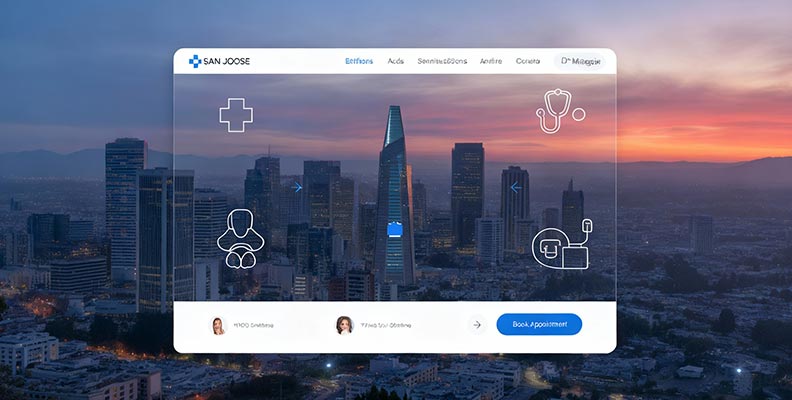In today’s healthcare landscape, digital presence defines patient trust. When potential patients search for specialists in San Jose, their first impression comes not from your reception desk—but from your website. If your site looks outdated or loads slowly, it silently damages your credibility. That’s why a healthcare website redesign is more than a facelift—it’s a strategic business upgrade that fuels visibility, conversions, and long-term growth.
At DBanerjee.com, every Website Redesign is built around empathy, accessibility, and measurable results. D. Banerjee and his team understand that specialty clinics require more than visual polish—they need SEO-driven architecture, HIPAA-compliant integrations, and a patient-first user journey that enhances trust and boosts appointment bookings.

Patients now research healthcare services online before ever making a call. They expect easy navigation, fast load times, and convenient online booking. If your website doesn’t meet these expectations, patients simply move on to a competitor.
A Business Website Redesign ensures that your digital touchpoints align with evolving patient expectations. It enables:
Incorporating these best practices into your healthcare website redesign increases engagement and strengthens your authority in local search results.
A clinic’s website is its digital waiting room. If it’s outdated or difficult to navigate, it projects disorganization. Through a carefully executed Website Redesign, your clinic can present a trustworthy, professional, and empathetic digital image that mirrors your quality of care.
Key design trust-builders include:
When patients see professionalism online, they’re more likely to book appointments offline.
Integrating advanced scheduling tools with your EHR or CRM enables patients to choose their doctor, insurance, and time slot instantly. This convenience reduces front-office workload and captures leads even after business hours.
By combining these systems with healthcare local SEO, your clinic becomes easier to find and easier to book.
AI chatbots act as round-the-clock receptionists. They answer basic questions, guide users to key pages, and capture emails for remarketing. Implementing chatbot workflows during your Website Redesign helps nurture prospects more efficiently and improves conversion rates.
A specialty clinic often has multiple verticals. With a thoughtful healthcare website redesign, you can create targeted landing pages for each service line—each optimized with relevant long-tail keywords, structured data, and educational content.
This not only improves discoverability but also filters inquiries, ensuring you attract patients actively seeking those specific treatments.
Educated patients are more confident and loyal. Adding a Patient Education Center with blogs, videos, and FAQs helps clarify procedures, recovery expectations, and aftercare. It’s an integral part of a Business Website Redesign that builds trust and supports your SEO strategy by targeting long-tail health-related queries.
Integrating analytics platforms like Google Tag Manager, GA4, and CRM tracking tools ensures every click is measurable. Data insights reveal which content or campaigns deliver the best ROI. This is where your website redesign SEO checklist plays a crucial role—it ensures your new site captures valuable behavioral data from day one.
Every healthcare organization must prioritize accessibility. A compliant site ensures inclusivity for users with disabilities and protects you from legal risks. Implement WCAG 2.2 AA standards, color contrast ratios, ARIA labels, and keyboard navigation.
Accessibility isn’t just ethical—it’s good business. It widens your audience and demonstrates care beyond the clinical setting.
During a Website Redesign, it’s common to restructure pages and URLs. Without a solid website redesign SEO checklist, you risk losing valuable rankings. To avoid this:
These steps preserve your domain authority while improving crawlability.
As clinics grow, content becomes complex—doctor bios, services, FAQs, and blogs. A content governance model defines who creates, reviews, and approves content, ensuring consistency and compliance.
This governance keeps your messaging unified while maintaining HIPAA accuracy. It’s a key differentiator between an average redesign and a strategic healthcare digital strategy.
Your layout should guide users effortlessly. Clear typography, structured headings, and intuitive CTAs like “Book an Appointment” reduce friction. Each scroll should serve a purpose—whether informing, engaging, or converting.
Creative designs are appealing—but without HIPAA and ADA alignment, they can create liability. Partnering with San Jose hospital website redesign specialists ensures compliance, security, and medical ethics are built into every design decision.
If URLs, metadata, or content hierarchy change during a Website Redesign, organic rankings can drop overnight. Use tools like Ahrefs or Screaming Frog to create an inventory before launch and implement your website redesign SEO checklist meticulously.
Outdated blogs, duplicate condition pages, and redundant staff listings bloat your site. Begin your healthcare website redesign timeline and milestones with a full content audit. Keep evergreen, high-performing content and consolidate low-value assets into updated, SEO-rich pages.
In healthcare, multiple voices—physicians, marketers, compliance officers—must align. Without structure, projects stall. Setting up a unified review process keeps the Business Website Redesign on schedule and consistent with branding.

A well-organized project timeline ensures clarity, accountability, and efficiency. Below is a step-by-step breakdown of what your healthcare website redesign journey typically looks like:

Integrating HIPAA-secure video platforms expands accessibility for remote patients. This feature has become a must-have for every healthcare website redesign project post-pandemic.
Add LocalBusiness and MedicalClinic schema to improve visibility for “near me” queries. Embed a Google Map with your NAP (Name, Address, Phone) for stronger local SEO signals.
Integrate verified reviews directly from Google or Healthgrades. Authentic feedback boosts credibility and improves conversions.
In culturally diverse cities like San Jose, offering multilingual website options improves accessibility and expands your audience base.
Implement analytics tools that respect patient confidentiality. Prioritize HIPAA-compliant data tracking and transparent cookie policies.
A redesign is only as strong as its outcomes. Track metrics consistently to ensure your investment drives measurable returns.
Key KPIs include:
By connecting analytics to your CRM, you can identify which service pages yield the highest ROI and continuously refine your strategy.
When you Redesign Your Website, aim to build a platform that performs as an educator, advocate, and conversion engine for your practice.
A truly successful healthcare website redesign balances three pillars:
At DBanerjee.com, D. Banerjee’s approach to Business Website Redesign merges design empathy with data science, producing websites that both heal and convert.
By implementing these innovations during your Website Redesign, your clinic stays ahead of both competitors and search algorithms.
1. What should a hospital website redesign include?
A comprehensive healthcare website redesign includes ADA compliance, mobile optimization, HIPAA-secure forms, telehealth integration, and optimized service-line pages.
2. How long does a healthcare website redesign take?
Depending on complexity, the process typically takes 12–16 weeks, covering audit, design, development, and testing phases.
3. Why is a website redesign SEO checklist important?
It ensures your site retains search rankings during migration. Without it, you risk losing visibility and patient traffic.
4. What’s the best way to redesign a website for healthcare compliance?
Work with San Jose hospital website redesign specialists experienced in HIPAA, ADA, and medical SEO requirements.
5. How does redesigning a website improve lead quality?
A focused Website Redesign improves UX, clarity, and search discoverability—resulting in more qualified leads and higher conversion rates.

A healthcare website redesign is not just a technical project—it’s a business transformation. When executed with purpose, it becomes a digital ecosystem that supports patient care, builds authority, and drives sustainable growth.
For specialty clinics in San Jose, investing in a thoughtful, SEO-optimized Business Website Redesign is the most effective way to future-proof your digital presence. With the right strategy, your website won’t just attract patients—it will empower them to trust your expertise before they ever walk through your doors.
Ready to redesign your website for better results?
Partner with DBanerjee.com—where data, design, and healthcare expertise come together to deliver high-performance digital solutions for specialty clinics.

A practical roadmap to integrating ADA standards with Web Development in Roseville for law firms

How Google decides top Rocklin legal websites and what attorneys should know about SEO Marketing Services in Rocklin

How Roofing SEO Services in Houston Boost Visibility With a Mobile-Friendly Website for Local Contractors

Get Website Development Services in Rocklin to boost leads for your Rocklin business today

How responsive web design Rocklin helps local businesses attract more nearby customers

7 Page-Speed Fixes a Website Designer in Roseville Uses to Lift Conversion Rates

D. Banerjee’s Guide to Website Design in Rocklin: What Your Site Needs to Rank